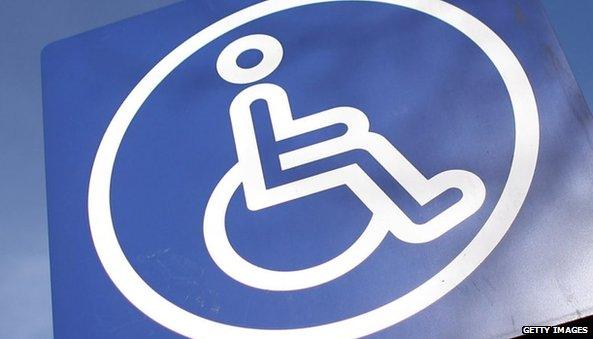Speeding up work for people with disabilities
- Published

Access for people with disabilities to work is just the beginning - and technology can help fulfill potential, Barbara Otto writes
In the early 1990s I was working for a women's organisation that publicised research around the use of "new" technologies, such as the desktop PCs and the fax machine, and how they were contributing to a phenomenon we called "work speed-up".
Essentially, these technologies, which replaced the slower typewriter, copier and mail systems, crunched the number of hours it took for administrative assistants to produce and distribute documents. However, these women were now expected to complete more work in the same eight-hour day.
Fast forward to 2012, and our workforce is in a similar situation. In a recent survey by Wrike, external, 83% of 1,074 respondents say they work from home after (or before) work hours, which allows them to get more work done - for the same pay.
Telecommuters say they use technology like real-time communication, high-speed network mobile devices, cloud-based applications and video-conferencing tools to facilitate the modern-day version of "work speed-up".
What's more is that telecommuting, and the technology it orbits around, creates a lifeline for one group in particular: people with disabilities.
Access to work
With technology, people with disabilities, many who are unemployed or under-employed, can now take a job and be highly productive. After all, this group is an incredible adopter of technology because they depend on it for their livelihood.
At the very basic level, Microsoft and Apple already incorporate accessibility utilities into their operating systems.
Social platforms like Twitter and Facebook are getting more accessible and, as an added benefit, are eliminating the need for people with physical or cognitive disabilities to type long-form communications.
There are many other promising technologies that I think will further help people with disabilities integrate into the 21st century workplace, include smartphones, apps, services, solutions and bionics.
Touchscreen devices like the iPhone, once assumed to be inaccessible to blind users, now offer "gesture" based technology for interacting with the phone's interface. Google's Android platform and the Apple iPhone 3GS also now include free screen readers, making them particularly popular among blind users.
Siri, a personal assistant application for the iPhone, is an incredibly useful tool for people with disabilities. Siri translates voice into text and understands basic commands and questions, letting users interact with applications.
Accessible virtual-work platforms like oDesk embrace technology for everything from project management to billing, and create a very level playing field for people with disabilities.
Smart environments, like networked video cameras, enable people with mobility disabilities to communicate with their computer, so users can work effectively with assistive software for text entry, web browsing, image editing, and animation.
Personal guidance systems based on geo-coded QR codes and social computing let individuals take photos with their smartphone, and be provided with geographical and other information - like exits, lift doorways, and entrances to stairways.
Voice biometric solutions verify a speaker's identity. Twinned with speech recognition, users can perform commercial transactions on a mobile phone entirely through automated conversation - a great solution for people with physical disabilities.

Using technology means people with disabilities are able to bring fresh perspectives to offices
For the deaf and hearing impaired, an app called SpeechTrans Ultimate lets them communicate with hearing people, who speak out loud into the user's mobile device, and the translated text automatically appears. It also integrates with Facebook chat.
The task management and organizational features on smartphones are helpful for people with cognitive impairments and autism. Also, apps like VoCal, which provides spoken word alerts to employees.
"Messages", an internet-based audio, text, and video conferencing application that is included with Macs, has high-quality video and frame rate capabilities and is ideal for people who use sign language to communicate.
The Tobii PCEye eye tracking system allows people with limited motor skills and certain neurological problems, to use their eyes to tell their computer what to do.
Schindler lifts, in use in hundred of high-rise buildings, use technology such as a personal identification card readers or keypads to understand the exact requirements of a user.
Added value
All of this is positive for the future of work because people with disabilities add tremendous value to the workplace.
People with disabilities are creative problem-solvers and technology adopters with fresh perspectives that organisations need.
Hiring people with disabilities enhances employee retention and engagement, as there are many job candidates with or without disabilities who want to work in holistically-diverse and socially conscious environments.
We've found they have low rates of absenteeism and turnover, which reduces a company's recruitment and retention costs.
Hiring the disabled helps companies develop new products and services, expanding their customer base, which is increasingly filled with older people starting to encounter disability.
All of this bodes well for the modern-day workplace.
I've said it before: If you want someone who thinks outside the box, hire someone who lives outside the box. So let "work speed up" begin for people with disabilities.
With new technologies on the horizon, we can tap this underused talent pool and move our notion of how and where we work solidly into the 21st century.
Barbara Otto is the principle of Think Beyond the Label, a private-public collaborative venture based in the US that aims to improve recruitment opportunities for qualified job candidates with disabilities.